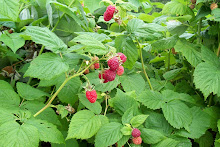 Five years ago a friend asked me if I wanted a clump of comfrey for my garden. I asked her what comfrey was used for. She answered, "Oh this and that. It comes in pretty handy in most circumstances." I took the comfrey, not quite knowing what to do with it. Now I can't ever see being without it, talk about a plant that can multi-task!
Five years ago a friend asked me if I wanted a clump of comfrey for my garden. I asked her what comfrey was used for. She answered, "Oh this and that. It comes in pretty handy in most circumstances." I took the comfrey, not quite knowing what to do with it. Now I can't ever see being without it, talk about a plant that can multi-task!Way back when, comfrey was commonly known as 'knitbone' and 'woundwort' because of its healing properties when it came to broken bones, sprains and bruises. I always have a jar of dried comfrey leaves to steep in boiled water for stubbed toes, bumped knees and so forth. For broken bones, I much prefer casts and slings but when my daughter broke her collar bone and a cast couldn't be used, a comfrey poultice came in pretty handy after a bath and before she put her sling on.
`
The kind of comfrey I have is commonly known as Canadian Comfrey and grows quite high, I can cut it down three times a year easy. Which is good because I use a lot of it. A couple of times through the summer I will take a big black garbage can and fill it with cut comfrey, add water, put the lid on tight and let it sit for three weeks. Occasionally, I will give it a stir with a rake or pitchfork just to keep everything aerated. After three weeks, that garbage can just reeks! I have to steady myself and steel my nerves before opening the lid, it's one of the worst smells I have ever encountered. But it's a great liquid fertilizer for my garden, it does wonders for my corn and tomatoes. I take a shower afterwards and leave my rubber boots outside until they stop smelling, that takes about a week. The garden will smell funny a few days too but the plants just love their comfrey tea.
Comfrey also comes in handy for the rabbits. Usually my rabbits will ignore comfrey if I put it in with their greens. But if a bunny is not feeling well, she will eat comfrey if her ailment is a digestive issue. So comfrey helps me diagnose the problem and helps in tummy troubles.
Comfrey is a pretty plant. Mine will grow over five feet high and it sprouts new shoots easily, making it a breeze to propagate. I now have it growing in three different spots and when it gets too big, I cut it down and pop it in the compost box to add a little boost in nutrients. I gave a clump to a neighbour to grow since he was having trouble with an old shoulder injury. He has since started using it as a decorative plant. He says it makes a nice backdrop to his garden. I'm beginning to line one part of our old wooden fence with it and it does look very pretty with it's broad green leaves and delicate purple flowers. The flowers, pale and raindrop shaped, show up in little shy groups at the top of the plants. The dark green leaves brings out the weathered grey in the fence and adds a touch of strength to the washed out color.
Some people do use comfrey internally, usually in a tea or even salads. But a few years ago, a couple of studies came out saying when consistently fed to rats comfrey caused liver problems including cancer. Well hell, anything seems to cause cancer in rats if fed in high enough quantities as far as I can tell. Don't feed it to rats! All joking aside, I just use comfrey externally and avoid the whole issue. Comfrey certainly helps around here in many different ways. I guess I could say it makes life a little more 'comfreytable'.

No comments:
Post a Comment